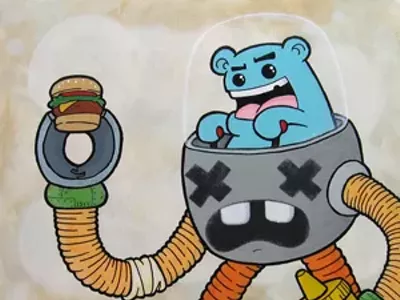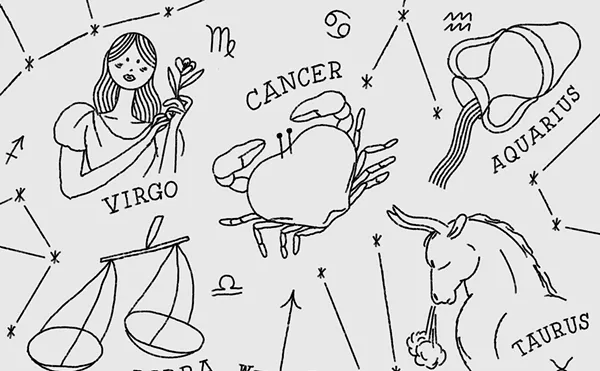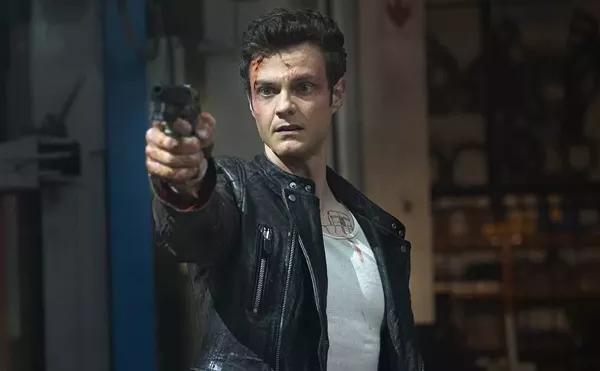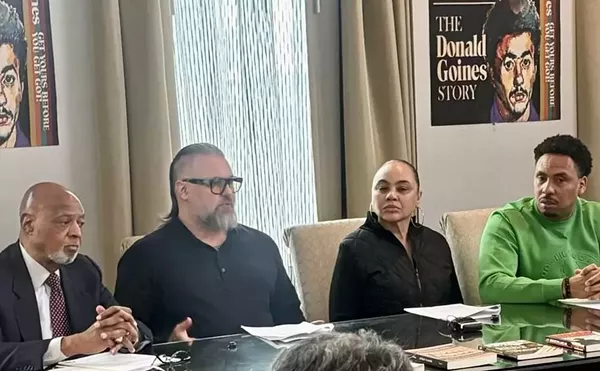Mario Moore says when painter's block hits, he bucks up and forces his hand to move about the canvas with whatever utensil is handy.
"Hell, yeah, art is hard," he says, "but you can't just stop."
He drops names like Rembrandt and Luther Vandross and cites social injustice — common themes for him — and "real hip hop, not that commercial shit" as keys to his work. Moore, a 21-year-old senior at the College for Creative Studies who graduates in May, comes off in his storytelling as a down-to-earth kid with an old man's soul, much like rap artists he adores, Nas and Common.
Moore comes from a family of artists. Dad works at the Detroit Institute of Arts and Mom's a fine artist. Bomani Ohkang Diop, another notable Detroit painter, and half of local rap duo Black Reign & Ohkang, is Moore's brother-in-law.
So here comes the age-old question: Are artists born or made?
"My dad always tells this story about the moment he knew I was going to be an artist," Moore says, pausing occasionally to take in art hanging on the walls at Cass Cafe. "So he comes and sits down next to me — I think he said I was 5 at the time — with a pencil and paper and draws a pumpkin man. It had all the basic elements of a pumpkin man, but he drew it very simply, with straight lines for arms and feet and whatnot. When he was done he puts the pencil in my hand and said, 'OK, now you do it.'"
The young Moore then crossed his old man's drawing out with a big X. Moore laughs: "I went on to draw a pumpkin man of my own and there was detail and a basic idea of shading and, for a 5-year-old kid, it looked pretty damn good."
Soon after, Mom let him sit in on figure drawing classes she taught. An apprehensive model was uncomfortable about posing in front of young Moore until he got up, walked over to his mom and said, "She's taking too long. She won't take her clothes off. I'm ready to draw!"
For a young, impassioned artist, age can get in the way of his work. "I'm at a bit of a disadvantage because I'm young," the painter says. "People sometimes believe I haven't matured in my work, or that I might change any moment, which is some crap."
Indeed it is. Sure, Moore was born in the late 1980s, but to see Moore solely through his work, you'd think he'd have some years on him. There's some wisdom in his paintings: There are frustrations of racial tension and powerful impressionist self-portraits, all defined with abilities to blend color and suggest shadow, while a small handful of geographic influences — namely Italy (where he studied for four months), Spain and South America — bleed quietly into the canvas.
A heady example is a self-portrait titled "I Gave You My Heart." In it, Moore's right hand pulls open a gaping hole in the center of his chest, where a trickle of blood makes its way down. His right hand holds his big, bleeding heart and he stares at it like it's something he used to know.
"I did that one over a girl," Moore says, blushing. Then he tells the story: "Me and this girl were kicking it for a while and everything was going real cool, but as hard as I tried to make our relationship more serious, she wouldn't want to. She'd just say, 'I like the way things are now.' One day she sends me a text message: 'I don't think we should kick it anymore.' And then she starts hangin' with my best friend." Moore pauses and shakes his head. "I learned she spent the night at his house once. ..."
Another painting tackles the realities of urban angst and senseless violence. In "What Can We Do & Say for Our Brothers," Moore sets a scene that sees five young black men kicking, punching and stomping a helpless, bloodied victim. On either side, confused and concerned onlookers struggle: Do they right a wrong or save their own asses?
"Too many times I've seen someone get jumped for no reason," Moore explains. "I was in line to get into a club called Bleu one time and some dudes just started to beat up this guy right in front of me. The frustration exists in the fact I want to help but I don't want to get my ass whooped for a guy that I don't even know." By painting these scenarios — ones in which Moore's emotions are tested — he finds understanding and then hopes to help raise awareness.
"Art can be a tool of persuasion," he says. "It can help us ask ourselves why we do things and bring attention to what still needs help in society."
A concern of Moore's is ageism. He has been passed over (and underappreciated) by galleries and "art appreciators," and so he has tried using his skills to change the way older generations appreciate art. And in ways that are life-affirming and ego-gratifying.
"I had a solo show at the YMCA downtown and, while I was standing around my work, I noticed a woman looking at a couple of my pieces, saying great things," Moore says. "I told her I was the artist — she did not believe me. My guess is that being young and black with talent was too much for her to handle. I escorted her to the section of my self-portraits and her jaw dropped. I loved that moment — that was awesome."
Moore continues to experience art-world growing pains, but he's gaining experience quickly, continuing to turn on folks and land gigs (most recently a commission for the cover of a novel titled Mama Got Rhythm & Daddy Got Soul). Focusing on art all week, and a DIA job on weekends, Moore lives and breathes the stuff. And why not?
"Man, artists grow throughout their lives — it doesn't end until you're buried under some dirt," he says, before he brings up age again. "Michelangelo was working on the Sistine Chapel much of the latter part of his life, he was in his 80s. I have my whole life ahead of me."
For more, see mariodmoore.com.






